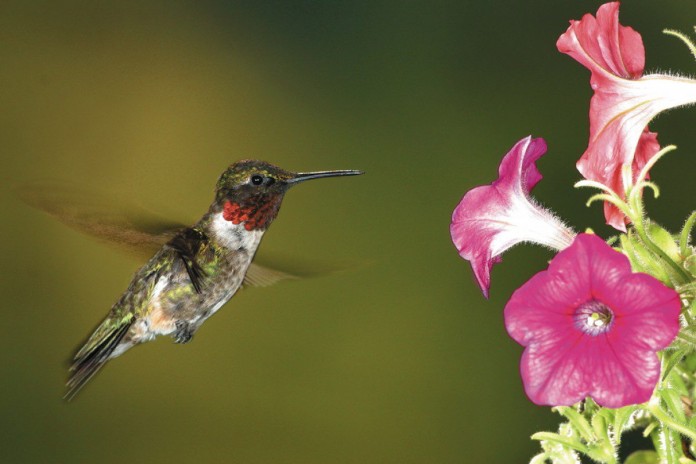So far this spring the weather has been totally unpredictable. One day the high temperature reaches 70 degrees, and the next it reads 42 degrees. Meanwhile, low temperatures dip into the 20s.
As exasperating as fluctuating temperatures are to us, they can really wreak havoc on migratory birds. Though the cue to migrate in spring is longer days, daily temperature extremes can be a problem.
Hummingbirds move north
For example, ruby-throated hummingbirds began arriving along the Gulf Coast in late February. Mild temperatures quickly sent them winging northward. On March 31, a hummer was reported in eastern Massachusetts. On April 2, one reached southeastern Pennsylvania, and the following day another reached central New Jersey.
At the same time hummingbirds had already reached central Missouri, southern Indiana and southern Ohio. Southern West Virginia had its first hummer report on March 30.
Check www.hummingbirds.net daily to monitor the northbound migration.
Feed nectar
Given these early return dates, it’s probably a good idea to get at least one nectar feeder up. Though these tiny, feathered dynamos can subsist on small invertebrates such as gnats and spiders, a reliable supply of high-energy nectar would certainly make their lives easier.
Nectar (one part table sugar, four parts boiling water, mix, cool and refrigerate) attracts hummingbirds, orioles and a surprising variety of other birds including downy woodpeckers, chickadees and finches. Nectar can also be used to attract insects that will attract a variety of insectivorous birds.
Insect feeder
An insect feeder is simple to set up. Start with some hummingbird nectar. Add some stale pancake syrup, juice from canned fruit, and blend the mixture with a soft, over-ripe banana. Place a small container of this sweet cocktail on a tray feeder. You may want to put this feeder in a far corner of the yard because it will attract bees and wasps as well as myriad other insects. And shortly after the insects arrive, so will the birds.
Almost all nesting birds feed their nestlings insects, so expect to see almost any bird at an insect feeder during the nesting season.
Changing locations
Keep in mind that spring migration is underway, so the array of birds that visit will change over the next six weeks. Even hummingbirds, will hover above the slurry and pick off gnats, fruit flies, and other soft-bodied insects. More evidence that spring weather is coming, regardless of extreme fluctuating temperatures, is that goldfinches are now molting into breeding plumage.
Goldfinches changing
All winter long, males have been dressed in drab olive, white, and dull black feathers. Now, most males show at least a few splashes of bright yellow, and some males already sport their full breeding colors.
The molt
Ornithologists call the feather replacement process “molt.” After nesting, it’s the most important thing birds do. Feathers are critical for survival. They are essential for flight, and they streamline, protect, and insulate the body.
Replacing feathers
Molt is simply the process of replacing worn feathers, which are made of the same tough material as human fingernails and hair. But feathers wear out. The constant beating feathers take from the elements exacts a steady toll.
Birds molt to counter this relentless wear. Replacing feathers, which make up four to 15 percent of a bird’s body weight, requires a lot of energy.
Timing is critical
Most birds simply can’t consume enough calories to molt and breed (or migrate) at the same time. Goldfinches molt before breeding while many delay the process until after nesting. Wing and tail feathers are usually lost and replaced a pair or two at a time, one from each side.
Balance
This ensures that the wings and tail remain balanced so molting songbirds can still fly.
Many water birds exhibit an entirely different molting strategy.
Flight feathers
Ducks, geese, swans, loons, grebes and many rails lose all their flight feathers (wing and tail) at once. This renders them flightless for four to 10 weeks, depending on the species. Water birds survive during this flightless period by living on a pond or lake that provides open water for feeding and nearby dense vegetation for escape cover.













